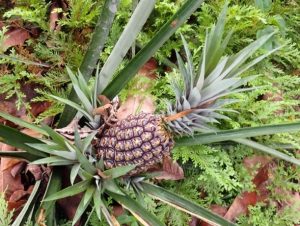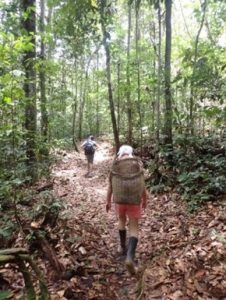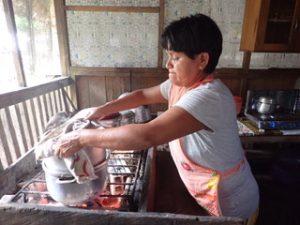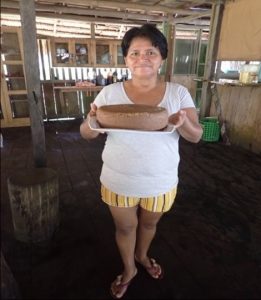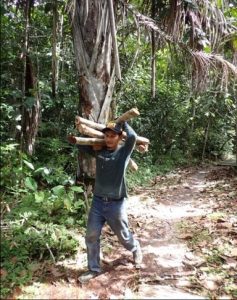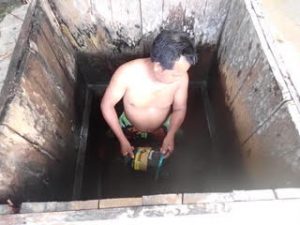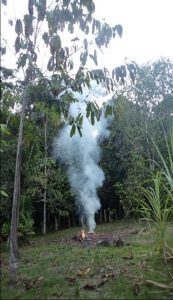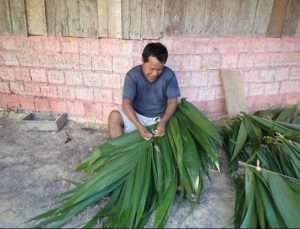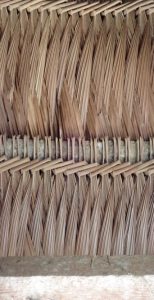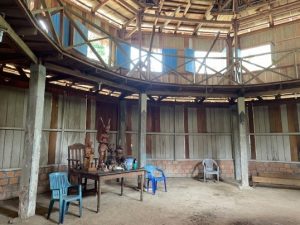.
Experiences in the Peruvian jungle
.
.
Daily life in Otorongo
.
.
In Otorongo, one should always expect the unexpected. I thought I would end my diet with a ceremony like in the beginning of my diet, but I was wrong! The ceremony consisted of a plate of raw onion rings mixed with raw garlic in a spicy sauce. Judith served it at 7 am on a little plate with the word “comer!”
“No comer” I answered, as I did not want to eat yet. She strongly insisted and only then I saw what was on the plate! The ending of my diet consisted of a bombshell and it catapulted me immediately back into the social environment and everyday life of Otorongo.
I had lost my appetite for black tea or coffee, but was looking forward to all the other delicious dishes Judith prepared for us.
.
.
.
.
.
Finally, I could eat fresh pineapple from the pineapple field
.
At least every second day, somebody had to bring food from the market of Tamshiyaku. Most of the time, Dr. Himmelbauer brought everything in his big basket.
.
.
.
.
.
.
Judith prepared a chocolate cake for me after I finished the diet and I was fascinated how she made it. She mixed all the ingredients in a bowl using only her hands, put it into a kettle and the kettle in a steam bath heated by a charcoal fired stove. The cake was delicious.
.
.
.
.
,
,
,
,
.
The charcoal was produced outside of the camp using a charcoal kiln made out of wood from collapsed trees and stored in a cabin near the kitchen. This storage place was a favorite place for scorpions who like it warm and dry. One time, Dr. Himmelbauer found a scorpion in his bed – the charcoal hut is located just beside his cabin.
.
.
.
.
.
.
.
.
.
.
Charcoal kiln in the making
/
.
A spring near my diet hut provided fresh and clear water for drinking and cooking.
.
.
.
.
Stalin getting water from the spring
.
.
In Peru, names are often given according to the power the parents wanted for the baby. A baby boy can even get the name Hitler.
Just three meters away of the pond, there was a well. The water of the well was used for washing laundry. Also, all the workers were washing themselves with water from the well.
.
.
.
.
.
.
Place of the well
.
.
.
.
Milton cleaning the really not very deep well
.
.
.
.
Laundry dried in the sun
.
Otorongo needs constant care and repair. Besides Milton and Luis, who are longtime workers in Otorongo, often other workers from the village come to the camp to help.
.
.
.
.
.
.
Raking the dead leaves from the camp ground was a daily activity and very important, as they could be hiding places for poisonous animals.
.
.
.
.
.
.
Dead leaves were always burned.
.
.
.
.
.
Chicken in Otorongo were not kept for eggs but for roaming the ground for snakes, scorpions and other poisonous animals. One time I saw a black hen with a black snake in its beak. Eggs were always left in the nest for breeding. However, sometimes a boa came during the night to steal them all.
In the center of the camp stands the octagonal temple building. It is there where the healing ceremonies are performed. The roof of the temple and other cabins are made of palm leaves and need to be repaired constantly.
.
.
.
.
Palm leaves dried in the sun for roof repair
/
/
/
/
/
.
Milton artistically weaving the palm leaves together
.
.
.
.
.
.
Pattern of woven palm leaves
.
Healing ceremonies take place during the night in a pitch-dark room and last up to three hours. Dr. Himmelbauer, a curandero, starts the ceremony a bit like a Catholic mass, asking for divine presence and protection. Then he offers the healing medicine called Ayahuasca, a plant essence made from the vine Ayahuasca, also called Madre or the vine of the dead. It takes one down to the unconscious mind and reveals suppressed and not healed topics in one’s personal life. The plant spirit is called up by songs (icaros) sung by the curandero. The participant stays conscious all the time.
.
.
.
.
.
Inside the temple
.
.
I was already familiar with Ayahuasca, but did not drink it during my diet. Also, due to the sickness of one visitor and Dr. Himmelbauer in addition to the volatile weather conditions with many thunderstorms, only a few ceremonies were performed during my diet time. I was fully participating after my three weeks of isolation. One time, I had a very strong vision of my ego cut into nonexistence and only pure awareness survived. I tried to be an observer, telling myself “I am love”, but it did not help. The I was still a hindrance to pure love.
.
.
.
.
.
Wooden ceiling of the temple
.
.
People often asked me after my return from the jungle – “what did you get out of it?” This question is not so easy to answer. After my Shikoku pilgrimage, I was asked the same question. There is usually not an immediate answer. Everything is a process and reveals itself later.
However, I realized some benefits of three weeks in the diet even during the diet. For example, my handwriting became even, small and precise when I wrote in my diary. In addition, nothing could disturb my equanimity after a while. I especially loved the simplicity of life and the joy and gratefulness for the essential things. I do not know yet what the long-term effects will be, if any. Time will reveal it.
At the end of my diet, Dr. Himmelbauer told me that during the last 20 years, twenty-five people had stayed in the diet hut. Five of them were women. Most of the women left early. I stayed the longest of the twenty-five people. It showed me that I have become fairly resilient, probably due to the pilgrimages I have done in the past.
Thank you so much, dear reader, for walking with me into the jungle and staying with me all the time.
Gassho,
Garyo

